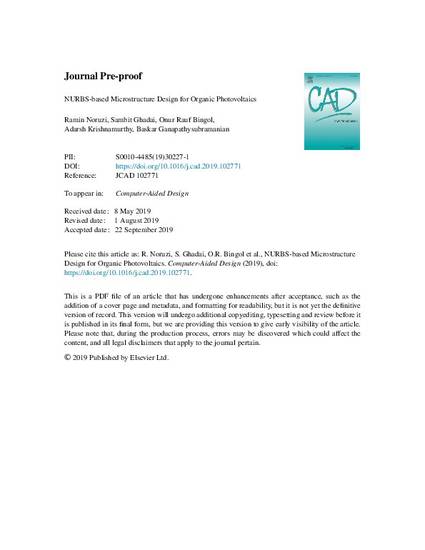
The microstructure – spatial distribution of electron donor and acceptor domains – plays an important role in determining the photo current in thin film organic solar cells (OSCs). Optimizing the microstructure can lead to higher photo current generation, and is an active area of experimental research. There has been recent progress in framing OSC microstructure design as a computational design problem. However, most current approaches to microstructure optimization are based on volumetric distribution of material, which makes the design space very large. In contrast, we frame the microstructure design optimization problem in terms of designing the interface between the donor and acceptor regions, and thus pose it as a surface representation and optimization problem. This results in substantially reduced number of design variables, thus enabling use of standard optimization tools. In this work, we address the efficient design of OSC microstructure by using surface and curve modeling techniques to model the donor–acceptor interface, and use meta-heuristic, gradient-free optimization techniques to optimize the microstructure for maximum short circuit current generation. Our modeling framework consists of three major components: (1) geometric modeling of OSC microstructure that uses Non-Uniform Rational B-spline (NURBS) curves and surfaces to construct the free-form donor–acceptor interface, (2) photo-current generation modeling that uses a parallel, finite-element based exciton–drift–diffusion (XDD) model, and (3) optimization that utilizes genetic algorithms (GA) to optimize the OSCs microstructure via exploration of the NURBS representation. We apply these methods for the optimization of both 2D and 3D microstructures. Results show substantial improvement in current density compared to the bulk-heterojunction microstructures. These results provide promising microstructures for experimental groups to fabricate. The proposed surface representation approach seems to be a promising approach for interface design in engineered systems.
Available at: http://works.bepress.com/baskar-ganapathysubramanian/91/

This is a manuscript of an article published as Noruzi, Ramin, Sambit Ghadai, Onur Rauf Bingol, Adarsh Krishnamurthy, and Baskar Ganapathysubramanian. "NURBS-based microstructure design for organic photovoltaics." Computer-Aided Design 118 (2019): 102771. DOI: 10.1016/j.cad.2019.102771. Posted with permission.